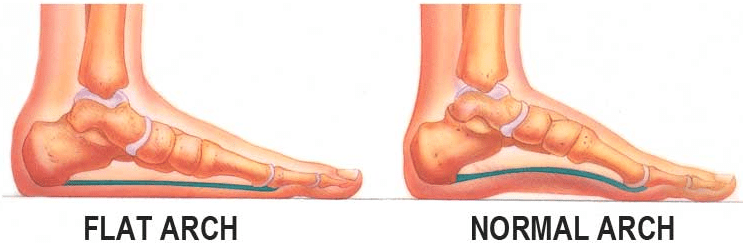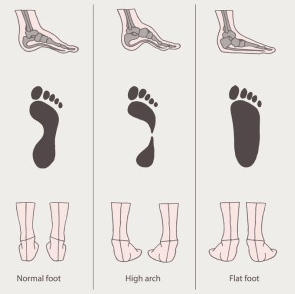FLAT FEET
A patient can have Flat Feet, or “Pes Planus”, to varying degrees. Keeping in mind that the foot has a natural arch created by the ligaments and tendons in your foot, flat feet begins to develop when this arch starts to fall. Thus, mild flat feet are seen when the foot starts losing it’s natural arch and severe flat feet are seen when the soles of the feet make full contact with the ground – a fully collapsed arch. When sitting, flat feet may not be noticed but once the foot is loaded, such as when standing, it is more easily visible. Considering that your feet support your whole body, it is important they are properly performing shock absorption and distributing pressure in order to avoid problems such as joint and back pain.

Causes
Flat Feet can be the result of multiple factors. Some of them may include:
- Weight gain or aging causing weakened muscles
- Foot injuries such as ankle sprains
- Genetics
- Standing or walking for a long period of time
- Wearing footwear with improper arch support
Additionally, it can be noted that many runners who wear improper footwear suffer from flat feet.

Symptoms
For mild cases of metatarsalgia, a good rest and some ice should provide short-term relief. For anyone who’s on their feet for extended periods of time, such as police officers and teachers, orthotics and the proper footwear are highly effective long-term solutions.
- Custom orthotics work by supporting the body’s frame through the foot. This is done by realigning the ankle and lower legs in order to correct the motion of the foot. In the case of Metatarsalgia, Rite Gait’s handcrafted custom orthotics will be designed to separate the metatarsal bones and cushion the forefoot correctly. They will include a metatarsal pad which is designed to lift and support the forefoot to reduce pressure and increase space between the bones in order to help you become pain-free.
- The proper footwear is important in the treatment of Metatarsalgia. Specifically, the footwear must not compress the toes, have a well-cushioned sole and stabilize the metatarsal bones to reduce pressure and minimize friction.
At Rite Gait, our pedorthists will handcraft your custom orthotics and help you find the perfect footwear in order to treat Metatarsalgia.
Treatment
Non-surgical treatment methods for Morton’s Neuroma include orthotics, the proper footwear, painkillers, nerve-blocking medicines and anti-inflammatory medicines. Custom orthotics and the proper footwear are highly effective for the following reasons:
- Custom orthotics work by supporting the body’s frame through the foot. This is done by realigning the ankle and lower legs in order to correct the motion of the foot. In the case of Morton’s Neuroma, Rite Gait’s handcrafted custom orthotics will be designed to separate the metatarsal bones and relieve pressure on the nerve. They will include a metatarsal pad which is designed to lift and support the forefoot to minimize friction and increase space between the bones in order to help you become pain-free.
- The proper footwear is important in the treatment of Morton’s Neuroma. Specifically, the footwear must not compress the toes, have a supportive sole and stabilize the metatarsal bones to minimize friction.
At Rite Gait, our pedorthists will handcraft your custom orthotics and help you find the perfect footwear in order to treat Morton’s Neuroma. Additionally, if we don’t already carry the perfect footwear to suit your needs, we can make modifications using the onsite lab.
MILTON LOCATION
- 335 Main St E, Milton, ON L9T 1P5
- (905) 876-1095
- ritegait@gmail.com
- WEEKDAYS: 10 AM - 6 PM
SATURDAYS: 9:30 AM - 2:30 PM
SUNDAYS: Closed